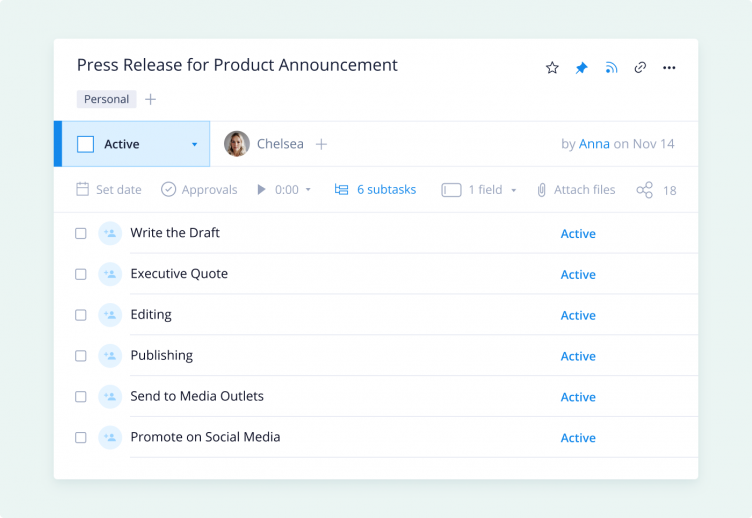Key takeaways:
- What is collaborative work management software (CWM)? CWM enhances team collaboration by offering a cloud-based platform to manage schedules, track updates, and streamline approvals.
- What are the benefits of using Wrike Free? Wrike Free allows unlimited users and supports subtask management, enhancing visibility and organization in project workflows.
- Why are subtasks important? Subtasks help break down complex projects into manageable steps, ensuring clarity and collaboration among team members.
- What features does Wrike Free include? Wrike Free offers task management, real-time activity streams, cloud integrations, and 2 GB of storage, all accessible for teams of any size.
- How can I start using Wrike? Sign up for Wrike Free today to streamline your work, collaborate effectively, and increase productivity beyond traditional spreadsheets.
Hard to believe that in this age of anti-aging drugs, tiny AI, and helicopters on Mars, there are still some teams that manage their work in a spreadsheet. (If this is you, nothing personal!) If you’re not locked in the cells that are the nearly 40-year-old spreadsheet, you may use multiple software applications to schedule work, track updates, collaborate, sign off on approvals, and advance work forward. There’s a better solution, one trusted by enterprise organizations, hyper-growth teams, and SMBs alike — a collaborative work management software (CWM).
If you’re not acquainted with or accustomed to managing all work in a cloud-based CWM platform, you’ll say — immediately after you plan schedules, communicate with your entire team in real time, upload assets for approval, and move work forward — why haven’t I been using a CWM solution?
Like anything there’s an adjustment period for most teams working in a collaborative work management software. To date, our global team has dedicated a lot of time and considered countless user feedback in building Wrike into the platform it is today. Not only are we proud of how robust Wrike is, but we want everyone who uses the platform to maximize efficiency and productivity, while saving time in the process. With Wrike’s updated Free plan, we’re expanding the accessibility to everyone who wants to manage their work in Wrike using a single source of truth.
What’s new with Wrike Free?
The existing Wrike Free plan included all of the following for five users:
- Board and spreadsheet view
- Task management
- File sharing
- Real-time Activity Stream
- Desktop and mobile apps
- Cloud storage integrations
- 2 GB of storage
Now, you get all of the above with two major enhancements:
- Unlimited users
- Subtask management
Providing unlimited users to the Wrike Free plan is a significant turning point because now teams of any size can work in Wrike, but you may be wondering, why are subtasks such a value add benefit?
Not all your work requires it to be labeled “top-level,” i.e., the primary project. Some of the work you do are smaller action items that support a bigger project or campaign. This supportive work should nest underneath the main project so that everyone on your team has visibility into all the work in progress and/or completed. Subtasks allow you to nest these supporting tasks where they belong.
(Note: Active task limitations apply, with a maximum of 200 active tasks.)
Subtasks: An example
Let’s say you’re announcing a new product via a press release. Here are some of the more common steps required to get this task out the door:
- Writing the draft
- Getting an executive quote
- Editing
- Publishing
- Sending the release to media outlets
- Promoting the release on social media
Without subtasks, all six steps would be included in one main task, “Press Release.” It would be a jumbled mess because each teammate would be collaborating, providing updates, and approving each piece in one long-running list of commentary. The more organized and efficient method is to assign each of these steps as subtasks, nested under “Press Release.”
Start your Wrike Free journey here
Once you’re managing all your work in Wrike, collaborating with teammates, and automating your workflows, the allure of your old spreadsheets will become a thing of the past. As you become more adept at using the platform, you’ll want to test out additional functionality in our Professional, Business, and Enterprise plans, like Work Intelligence, capacity planning, enhanced security features, and more.
Whether you’re a project manager, part of a marketing team, professional services, product development, work in an agency, PPM, or work remote or a hybrid model, Wrike’s collaborative work management software is customizable to you and has the functionality you need.
Start with the basics and Wrike Free. Tell your friends, your teammates, your boss. Sign up for Wrike Free today and start doing more of your best work.









